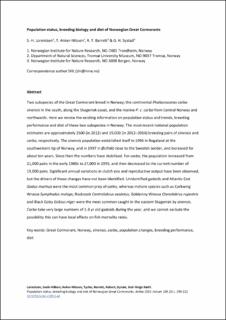Population status, breeding biology and diet of Norwegian Great Cormorants
| dc.contributor.author | Lorentsen, Svein-Håkon | |
| dc.contributor.author | Anker-Nilssen, Tycho | |
| dc.contributor.author | Barrett, Robert | |
| dc.contributor.author | Systad, Geir Helge Rødli | |
| dc.coverage.spatial | Norway, Skagerak, Rogaland, Østfold | en_US |
| dc.date.accessioned | 2022-08-29T10:36:06Z | |
| dc.date.available | 2022-08-29T10:36:06Z | |
| dc.date.created | 2022-08-03T09:22:29Z | |
| dc.date.issued | 2021 | |
| dc.identifier.citation | Ardea. 2021, 109 (3), 299-312. | en_US |
| dc.identifier.issn | 0373-2266 | |
| dc.identifier.uri | https://hdl.handle.net/11250/3014109 | |
| dc.description.abstract | Two subspecies of the Great Cormorant breed in Norway, the continental Phalacrocorax carbo sinensis in the south, along the Skagerrak coast, and the marine P. c. carbo from central Norway and northwards. Here we review the information existing until 2017 on population status and trends, breeding performance and diet of these two subspecies in Norway. The most recent national population estimates are approximately 2500 (in 2012) and 19,000 (in 2012–2014) breeding pairs of sinensis and carbo, respectively. The sinensis population established itself in 1996 in Rogaland at the south-western tip of Norway, and in 1997 in Østfold close to the Swedish border; in both areas it increased for about ten years. Since then, the numbers have stabilised. For carbo, the population increased from 21,000 pairs in the early 1980s to 27,000 in 1995, and then decreased to the current number of 19,000 pairs. Significant annual variations in clutch size and reproductive output have been observed, but the drivers of these changes have not been identified. Unidentified gadoids and Atlantic Cod Gadus morhua were the most common prey of carbo, whereas inshore species such as Corkwing Wrasse Symphodus melops, Rockcook Centrolabrus exoletus, Goldsinny Wrasse Ctenolabrus rupestris and Black Goby Gobius niger were the most common prey in the eastern Skagerrak caught by sinensis. Carbo took very large numbers of 1–3-year-old gadoids during the year, and we cannot exclude the possibility this can have local effects on fish mortality rates. Great Cormorant, Norway, sinensis, carbo, population changes, breeding performance, diet | en_US |
| dc.language.iso | eng | en_US |
| dc.subject | Great Cormorant | en_US |
| dc.subject | Norway | en_US |
| dc.subject | sinensis | en_US |
| dc.subject | carbo | en_US |
| dc.subject | population changes | en_US |
| dc.subject | breeding performance | en_US |
| dc.subject | diet | en_US |
| dc.title | Population status, breeding biology and diet of Norwegian Great Cormorants | en_US |
| dc.title.alternative | Population status, breeding biology and diet of Norwegian Great Cormorants | en_US |
| dc.type | Peer reviewed | en_US |
| dc.type | Journal article | en_US |
| dc.description.version | acceptedVersion | en_US |
| dc.subject.nsi | VDP::Zoologiske og botaniske fag: 480 | en_US |
| dc.subject.nsi | VDP::Zoology and botany: 480 | en_US |
| dc.source.pagenumber | 299-312 | en_US |
| dc.source.volume | 109 | en_US |
| dc.source.journal | Ardea | en_US |
| dc.source.issue | 3 | en_US |
| dc.identifier.doi | 10.5253/arde.v109i2.a4 | |
| dc.identifier.cristin | 2040815 | |
| dc.relation.project | Andre: Norwegian Environment Agency | en_US |
| cristin.ispublished | true | |
| cristin.fulltext | postprint | |
| cristin.qualitycode | 1 |
Tilhørende fil(er)
Denne innførselen finnes i følgende samling(er)
-
Publikasjoner fra CRIStin - NINA [2364]
-
Scientific publications [1392]
Vitenskapelige artikler, kapitler og monografier i Open Access.
